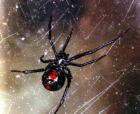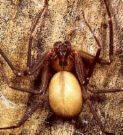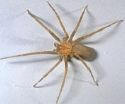
The black widow spider (Latrodectus
mactans) is a spider notorious for its neurotoxic venom. It is a large
widow spider found throughout the world and commonly associated with urban
habitats or agricultural areas. Although the common name 'black widow spider' is
used to refer specifically to L. mactans it is occasionally also applied
to several members of the Latrodectus (widow spider) genus in which there
are 31 recognized species including the Australian red-back and brown widow
spider. In South Africa, the black widow is also known as the button spider.
This well known and misunderstood pest is famous for its mating rituals where the female kills and consumes the male after copulating. The male Black Widow spider is smaller and totally harmless to man. The female is easily identified by the red hourglass shape on the abdomen. Black Widow poison is 15 times more lethal than rattlesnake venom; however, less poison is actually injected in a bite so far fewer people die from spider bites. Black Widows prefer dark, humid places like wood piles, basements, and crawlspaces. Modern pest control methods are very effective in controlling and preventing spider infestations.
Adult female black widow spiders are shiny black with an hourglass shaped marking on the bottom of its abdomen which, although most commonly red, may range in color from white to yellow to various shades of orange and red. They also bear a small, usually red (colors vary) dot near the spinerettes, which is separate from the hourglass. In some varieties, the two halves of the hourglass shape may be separated into two separate dots. A large female black widow spider can grow to 1.5 inches (38 mm), counting legspan. The body is about 0.5 inches (13 mm). Male black widow spiders are half the size of the female or smaller. They have longer legs and a smaller abdomen in relation to their body size. They are also usually dark brown with varying colors of stripes/dots, with no hourglass mark. Adult males can be distinguished from juvenile females by their more-slender body, longer legs and large pedipalps typical of most other male spiders. Juvenile black widow spiders start white, molting to dark brown to black exoskeletons with white, yellow, orange and red stripes and/or dots on their backs.
As with many poisonous creatures, the
brightly coloured markings serve as a warning to predators. Eating a blac k
widow will normally not kill a small predator (birds, et cetera), but the
sickness that follows digestion is enough for the creature to remember that the
bright red means not to eat. Because the adult female black widow typically
hangs and moves about its web upside down, its hourglass is on its front.
However, juvenile widows (female) spend a large quantity of time in search of an
optimal environment. Once an optimal location is found, adult female widows
often spend their entire lives in one place. However, because juvenile females
must first find this optimal location, they bear brightly colored marks upon
their backs, so that they may be seen by predators when the widow is travelling
upon its legs. Males bear similar marks to the females to serve as warning while
they are searching for mates, however, the marks are not as prominent (not as
brightly colored, or as large). Males, being less poisonous, are less of a
threat to predators, so having similar marks not as prominent helps predators to
better judge their prey (some large birds can eat male widows without adverse
effect, and so only avoid female widows. Those who cannot eat any widow without
adverse effect eat nothing with the marks.) Female juveniles develop an
hourglass before the dorsal markings are shed.
k
widow will normally not kill a small predator (birds, et cetera), but the
sickness that follows digestion is enough for the creature to remember that the
bright red means not to eat. Because the adult female black widow typically
hangs and moves about its web upside down, its hourglass is on its front.
However, juvenile widows (female) spend a large quantity of time in search of an
optimal environment. Once an optimal location is found, adult female widows
often spend their entire lives in one place. However, because juvenile females
must first find this optimal location, they bear brightly colored marks upon
their backs, so that they may be seen by predators when the widow is travelling
upon its legs. Males bear similar marks to the females to serve as warning while
they are searching for mates, however, the marks are not as prominent (not as
brightly colored, or as large). Males, being less poisonous, are less of a
threat to predators, so having similar marks not as prominent helps predators to
better judge their prey (some large birds can eat male widows without adverse
effect, and so only avoid female widows. Those who cannot eat any widow without
adverse effect eat nothing with the marks.) Female juveniles develop an
hourglass before the dorsal markings are shed.
The brown recluse spider is a
venomous spider, Loxosceles reclusa, of the family Sicariidae (formerly
of the family Loxoscelidae). It is usually between 1/4 and 3/4 inch
(6.4-19.1mm) but may grow larger. It is brown and usually has markings on the
dorsal side of its thorax, with a black line coming from it that looks like a
violin with the neck of the violin pointing to the rear of the spider resulting
in the nickname "fiddleback spider" or "violin spider". Coloring varies from
light tan to brown and the violin marking may not be visible. The brown recluse
spider is native to the United States from the southern Midwest south to the
Gulf of Mexico. It is native from central Texas to western Georgia. Recluse
spiders, which also include Mediterranean recluse spider (Loxosceles ru fescens),
build irregular webs that frequently include a shelter consisting of disorderly
threads. Unlike most web weavers, they leave these webs at night to hunt. People
get bitten when they unintentionally squeeze them in clothing and bedding.
fescens),
build irregular webs that frequently include a shelter consisting of disorderly
threads. Unlike most web weavers, they leave these webs at night to hunt. People
get bitten when they unintentionally squeeze them in clothing and bedding.
These spiders frequently build their webs in woodpiles and sheds, closets, garages, and other places that are dry and generally undisturbed.
As indicated by its name, this spider is not aggressive and usually bites only when pressed against human skin, such as when putting on an article of clothing. Actual brown recluse bites are rare and few. The initial bite frequently cannot be felt. Most bites are minor with no necrosis, but a small number produce severe dermonecrotic lesions or even systemic conditions (viscerocutaneous loxoscelism) with occasional fatalities. (For a comparison of the toxicity of several kinds of spider bites, see the list of spiders having medically significant venom.)
It is estimated that 80% of reported brown recluse bites may be misdiagnoses. The misdiagnosis of a wound as a brown recluse bite could delay proper treatment of serious diseases. There is now a test for brown recluse venom that can determine if a wound is a brown recluse bite.
The serious bites form a necrotising ulcer
that destroys soft tissue and may take months and very rarely years to heal,
leaving deep scars. The damaged
tissue will become gangrenous and eventually slough away. Initially there may be
no pain from a bite, but over time the wound may grow to as large as 10 inches
(25 cm) in extreme cases. Bites may take up to seven hours to cause visible
damage; more serious systemic effects may occur before this time, as venom of
any kind spreads throughout the body in minutes. Deaths (1.5% of all cases) have
been reported for the related South American species L. laeta and L.
intermedia.
scars. The damaged
tissue will become gangrenous and eventually slough away. Initially there may be
no pain from a bite, but over time the wound may grow to as large as 10 inches
(25 cm) in extreme cases. Bites may take up to seven hours to cause visible
damage; more serious systemic effects may occur before this time, as venom of
any kind spreads throughout the body in minutes. Deaths (1.5% of all cases) have
been reported for the related South American species L. laeta and L.
intermedia.
First aid involves the application of an ice pack to control inflammation, the application of aloe vera to soothe and help control the pain, and prompt medical care. If it can be easily captured, the spider should be brought with the patient in a clear, tightly closed container so it may be identified. However, by the time the bite is noticed any spider found nearby is not likely to be the culprit.